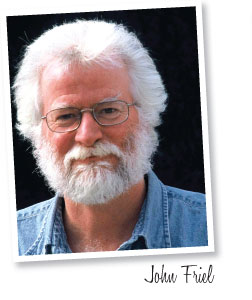10/1/2022
Glad We Grow This, Wish We Grew That
John Friel

It’s been a tough couple of years for scoping out exciting new plants. Travel restrictions, trade shows canceled or gone virtual, and historic demand for our products all conspired to keep many of us home.
But two recent events, Cultivate’22 and the Perennial Plant Association’s National Symposium, featured interesting new goodies. At Cultivate, my favorites in the New Varieties Zone were:
• Infertile Miscanthus High Frequency, a brightly-variegated 5-footer. But only my employer has it, and this isn’t an infomercial, so let’s move on.
• Verbena bonariensis Vanity: A new take on a tender (Zone 7 to 11) perennial I’ve always liked. This 2022 AAS Award-winner also boasts a Fleuroselect Gold Medal. The Royal Horticulture Society bestowed its Award of Garden Merit on the species in 2002. About time: It’s been cultivated in England since 1726. Apparently RHS’s deliberations are deliberate indeed.
Butterflies love this species. Its flowers hold color and long stiff stems make it a good cut. It’s an American native, if your definition of “American” extends to Argentina: bonariensis means “from Buenos Aires.”
Those clustered purple blooms are maddening to photograph. Always in motion, they’re small and scattered enough that my pictures usually resemble swarms of oddly-colored bees in flight. I thought Vanity had significantly larger blooms than the species, but I haven’t seen them side-by-side. It’s shorter (30 in. vs. 5 ft.) and more compact.
Among the PPA symposium’s reliable charms is the New Plants Forum, now labeled New To The Market. Highlights:
• Kniphofia Glowstick is a stunner. Long-lasting, repeat-blooming columns of bright yellow flowers draw your eye instantly, insistently, from anywhere in or near the garden. A versatile 30-in. tall, it’s hardy to Zone 6.
• Ficus carica Fignomenal was an odd fit among the herbaceous perennials, but a great fit for a burgeoning trend: “Foodscaping.”
I’m not sure who coined that brilliant term, but I credit Brie Arthur, whose book, “The Foodscape Revolution,” was where I first saw it. COVID-19 pushed it along, as people stuck at home with time on their hands discovered, or rediscovered, gardening. With so much seemingly out of control, bringing new life from the soil affords tremendous satisfaction. Growing edibles as well as ornamentals = self-sufficiency, ergo control. Combining edibility and beauty makes homegrown food HOA-proof.
Discovered in Northeastern PA, Fignomenal is compact enough to bring indoors for winter. Said to be hardy to Zone 7A, it stands less than 30-in. tall.
• Sorghastrum nutans Golden Sunset: Another impressive selection by Dr. Mary Myers in Minnesota. Is it the next Calamagrostis Karl Foerster? Much too early to tell. But it’s got serious chops: A sturdy upright habit, olive-green blades, no apparent rust issues and gorgeous gold plumes. A manageable 4 ft. to 5 ft., it’s hardy in Zones 3 to 10!
• Phlox carolina Kim: This pretty species simply never sold for us. It’s a charmingly short native with an un-charmingly brief bloom time. Catalogs enthuse that it’s smothered in pink flowers from “late May to early June.” Sounds good, but really, that’s anywhere from two days to two weeks. This Alabama discovery, 2-ft. tall and hardy to Zone 5, has been around for at least a decade, but it just blipped my radar this year. Apparently, I’m not alone: There it was at New To The Market.
Elsewhere at PPA:
• Black-leaved Sedums: This elusive breeder’s Grail has been disappointing, prone to flopping, sprawling and bird-nesting. But the future looks promising. Presenters praised Black Knight (Dolseb), Back in Black and the Mojave Jewels series.
• Delosperma Ocean Sunset series: These three varieties bloomed from April ’til Thanksgiving in central New Jersey. Not too shabby!
A sad, but oddly liberating, statement: You can’t grow everything. No one can.
But, really, that’s a good thing. If you could grow what I grow, and vice-versa, we’d never sell each other anything. GP
John Friel is marketing manager for Emerald Coast Growers and a freelance writer.